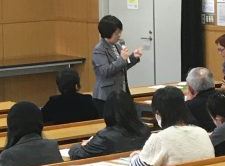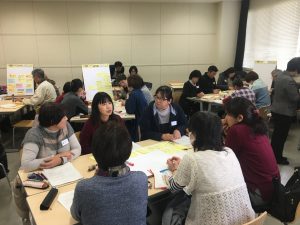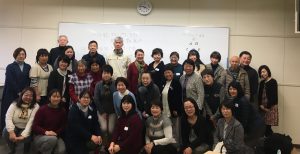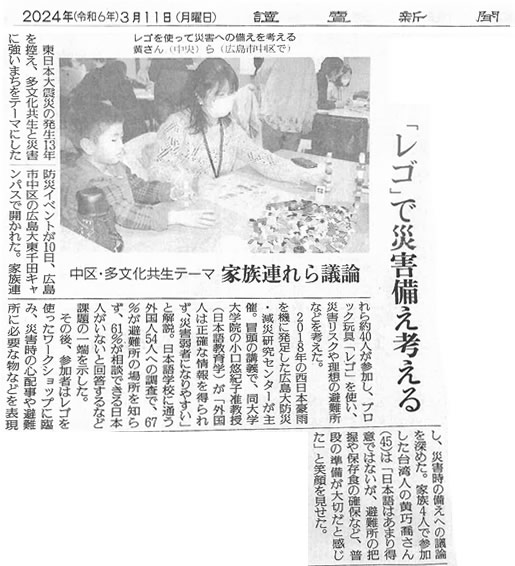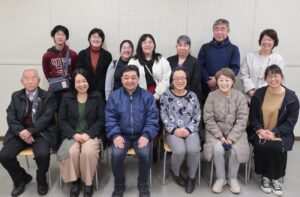Women and Disaster Risk Reduction
March 10th, 2024
Multiculturalism And Disaster Resilience
~Communication Workshop with LEGO~
(Hiroshima University Resilience Research Center, Open Discussion 2023)
【Summary】
The number of foreign residents in Japan is increasing year by year. Hiroshima Prefecture is no exception, with the number of foreign residents exceeding 50,000 in FY2021. Hiroshima is a major tourist destination, with many visitors from abroad, and many local cities and towns have a large number of foreign workers. Therefore, we created an opportunity to understand the diversity of people from different cultural backgrounds and to respect each other by using LEGO bricks to think of an ideal evacuation center for everyone.
Click here for the program flyer
The first half of the program consisted of a presentation of the results of the municipal survey, followed by a lecture and explanation of the work by Yukiko Koguchi, associate professor at Hiroshima University (Japanese Language Education). About 40 people, including families and non-Japanese, participated in the workshop.
In the latter half of the workshop, the participants had a good time talking with the children. They responded to a questionnaire after the session with comments such as, “I enjoyed learning with LEGO.” “ The Lego approach created a dialogue.”
The event was broadcast on TV Hiroshima on March 10, 2024.
テレビ広島放送リンク(TV Hiroshima)
The event was featured in the Yomiuri Shimbun on March 11, 2024.
Disaster Risk Reduction from the Perspective of Gender Equality
~Towards Efforts to Connect in the Community
(The seminar was held in person on Sunday, February 12, 2023, for the first time in two years.)
【Summary】
In Japan, local governments are currently promoting various initiatives based on the National Guidelines for Disaster Risk Reduction from a Gender Equality Perspective. In some areas, women are involved in disaster risk reduction. How about Hiroshima? Let’s rethink what women can do to contribute to disaster risk reduction based on local examples.
In the first half of the program, Ms. Kyoko Kagawa of the Hiroshima NPO Center presented the results of her own survey on the efforts of local governments and Ms. Sachiko Asano, Chairperson of the National Committee for the Formulation of “Disaster Risk Reduction Guidelines from a Gender Equality Perspective,” gave her comments.
Ms. Kyoko Kagawa, “Questionnaire for Municipalities on Disaster Risk Reduction and Evacuation Center Management from a Gender Equality Perspective” (Slide link)
Ms Sachiko Asano who is a co-funder of the Training Centre for Gender and Disaster Risk Reduction provided an insightful comments on the survey result. She introduced some case studies how we can be pro-active to change people community perspective as well as how we can find the gap that we can communicate with local government to be involved in the community DRR activities, thank you Ms Asano!
In the middle of the session, Ms. Naoko Tamaki, a disaster prevention specialist and member of the Women’s Disaster Reduction Network, gave a presentation entitled “What Women Can Do in the Community as Disaster Prevention Specialists”; Mr. Norihiro Nishidai, a voluntary disaster prevention adviser and disaster prevention specialist from Hiroshima Prefecture, gave a presentation entitled “Disaster Prevention from the Perspective of Gender Equality: A Family Discussion”; and Ms. Yoko Goto of Rental Space & Old Private House gave a presentation titled “Community Connections after the Torrential Rain Disaster in Western Japan: Through Old Private House Activities”.
Ms. Naoko Tamaki Presentation (Slide Link)
Ms. Yoko Goto Presentation (Slide Link)
Finally, the participants were divided into groups, and each group discussed current issues, who they would like to work with and how they would like to work on them, and what is needed to promote various forms of Disaster Risk Reduction efforts in the community, not only by women but also by various other people, to clarify what they can do.
Efforts were televised by NHK Hiroshima on February 12, 2023.
https://www3.nhk.or.jp/hiroshima-news/20230212/4000021273.html
The initiative was published in the Yomiuri Shimbun on March 5, 2023.
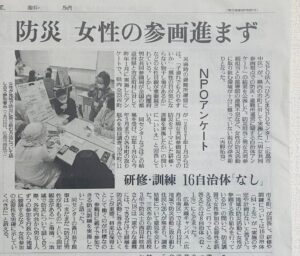
Let’s create a community where children can live with a sense of security!
(Held on February 11, 2022, Completed.)
【Summary】
Disasters happen again and again every day and year around.
Even if you are survived in a disaster, changes in the environment often impact on the safety of children’s life, consequently their mental and physical health. Through this program, why don’t we rethink the community where children can live with a sense of security?
In the first half of the program, we welcomed Professor Nahoko Harada from the Department of Nursing, Faculty of Medicine, University of Miyazaki, who gave a lecture titled “Minimum Standards for Child Protection in Humanitarian Action”. The second half of the program will be a workshop.
Prof Harada talks about what humanitarian supporters need to pay attention for children to stay safe and secure without being exposed to danger in the case of emergency, such as disasters.
Click here for the program flyer

Let’s talk about evacuation centres to accommodate diverse needs in the community!
(Held on February 11, 2021, Completed)
【Summary】
We experience frequent and severe disasters in Japan. Many of the affected people by these disasters require special care and attentions in their daily lives. This attention should be paid not only during the non-disaster period but also during the disaster period. Through this program, why don’t we re-think evacuation and sheltering for people who have various needs and diversity in our community?
The first half of the program will be led by Ms. Emiko Nukui, who will talk about her community disaster risk reduction activities, particularly to protect the lives of children with disabilities. Her disaster risk reduction work is to disaster prevention and reduction, and being creative activities to protect their souls. In the latter half of the session, we will have a group discussion. (First 40 people, free of charge)
Click here for the program flyer
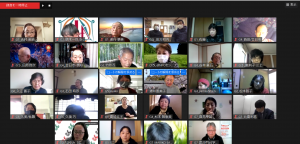
Although it was only a half-day program, we learn from the lecturer, Ms. Emiko Nukui, about specific evacuation approaches with people with disabilities living in the community, as well as actions that we can take, and how to be sensible to those actions. In order to achieve the goal of “leaving no one behind” in our community, we felt that it is important to be aware what is being taken for granted and challenge them.
In the second half of the workshop, the participants joined the group work and created their own group slogans.
Here are the top three slogans selected by participants voting. It is hard to translate as the slogan looses the Japanese pans and sayings in English, but we hope that you can catch the essence of these slogans!
No. 1: 1G Let’s communicate with each other in the spirit of mutual help, in the good neighborhood. Let’s call out over next three houses (mukou sangen donari) for mutual support (There is a term “over there houses”(mukou sangen donari in Japanese, it implies that the neighborhood that you are more likely to communicate each other in your neighborhood )
No. 2: 5G Let’s help each other and share the joy of life.
No. 3: 2G Know your neighbors better to protect your life. Let’s call out for help!
Thank you to all the participants for your hard work!
Let’s talk about evacuation centres to accommodate diverse needs in the community!
Registration for enroll is currently open
What are the effective programs to support women’s empowerment in disaster risk reduction efforts in Hiroshima? (held in 2020)
【Summary】
What is the role of women in disaster risk reduction in Japan, how has it changed in recent years, and where we are heading for ? We will invite two lecturers who are active nationwide in the field of women and disaster risk reduction to deepen our understanding of local practices as well as governmental policies changes. In the afternoon workshop, participants will have an opportunities to introduce and and share their current issues and solutions, including those with and without experience in disaster relief, with the aim of developing a message from the participants of this program.
Click here to find the program report
Program Outline
- *Introduction
*Keiko Ikeda (Professor, Faculty of Education, Shizuoka University, Center for Integrated Research and Education of Natural Hazards, Shizuoka University)
“Current Situation and Issues of Disaster Reduction from Gender Perspective”
- Please click here for the document file
(Please refrain from using or reprinting without permission)
Part1
Part2
- *Sakiko Kanbara (Professor, Faculty of Nursing, Kochi Prefectural University)
“Women in Mabi Town, Kurashiki City in the Torrential Rains in Western Japan and Afterwards - Click here to view the file.
(Please refrain from using or reprinting without permission)
Part1
Part2
| Date & Time: | (Registration starts at 9:30 a.m.) |
|---|---|
| Place: | Hiroshima University, Kasumi Campus, Health Sciences Building Lecture Room 203 Workshop Room 301 |
| Fee: | Free of charge(First 40 people for the workshop) |
